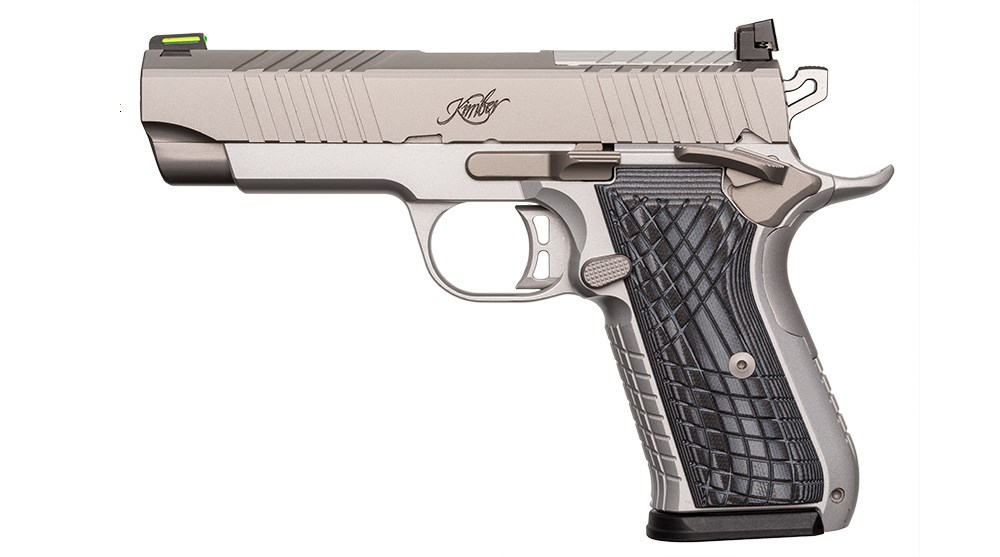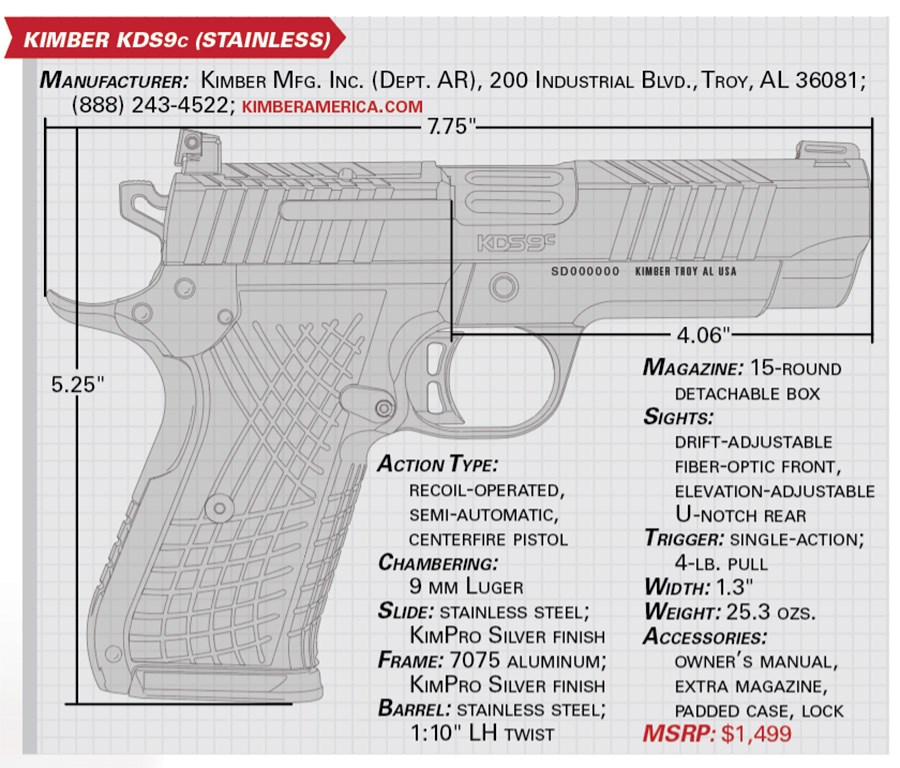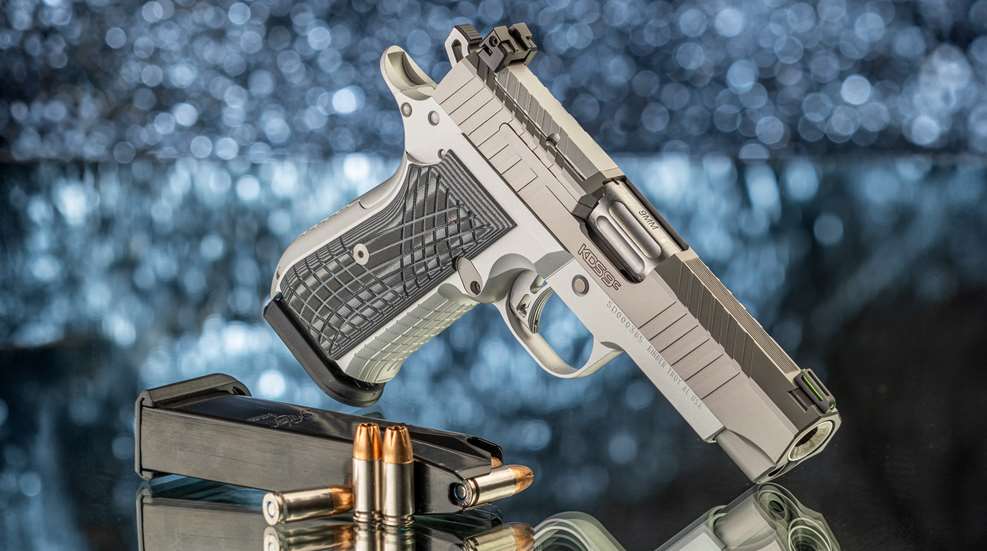
Kimber, known for its M1911-style pistols among its catalog of arms, is today one of the country’s prominent handgun manufacturers. But it wasn’t always that way. The then-riflemaker made a bold move in the mid-1990s to bring to market a factory M1911 pistol with many of the features that, before then, had been exclusively a custom proposition for shooters. One of the hot trends in the past few years has been the M1911’s expansion into the custom market of single-action, carry-size guns in 9 mm Luger featuring double-stack magazines—so-called 2011-style guns—such as the Wilson Combat X9 series and others from boutique makers. So, Kimber has once again answered market demand by bringing custom quality to main street with its new KDS9c—a carry-size, “2011” with a 15-round magazine.
The KDS9c combines M1911 functionality, controls and styling with a top end that bears similar lockup, extraction and optics compatibility with many popular, contemporary 9 mm striker-fired compacts. It is a welcome addition to the market, attempting to combine the traditional upsides of the M1911 platform with features well-established and familiar to shooters on recent designs.
The first “nice” carry gun I splurged on was a Kimber Elite Carry Officer from the company’s custom shop around 1999. In Colt parlance, it combined a bushingless Commander-length barrel with a lightweight Officer-size grip frame that was a perfect M1911 alternative similar in size to the Glock 19/23s that were quickly sweeping the concealed-carry market. I carried that little Kimber for seven years or so as what today we would call my everyday carry, or EDC, gun. Full-power .45 ACP loads were a bit rowdy in that little pistol, and I often wished for something that retained the shootability and joyfully slim and comfortable profile of that M1911 with the capacity of the popular SIG P229s and Glock 19s of that era. The KDS9c is in many ways the expression of my handgunner’s daydreams from that time.
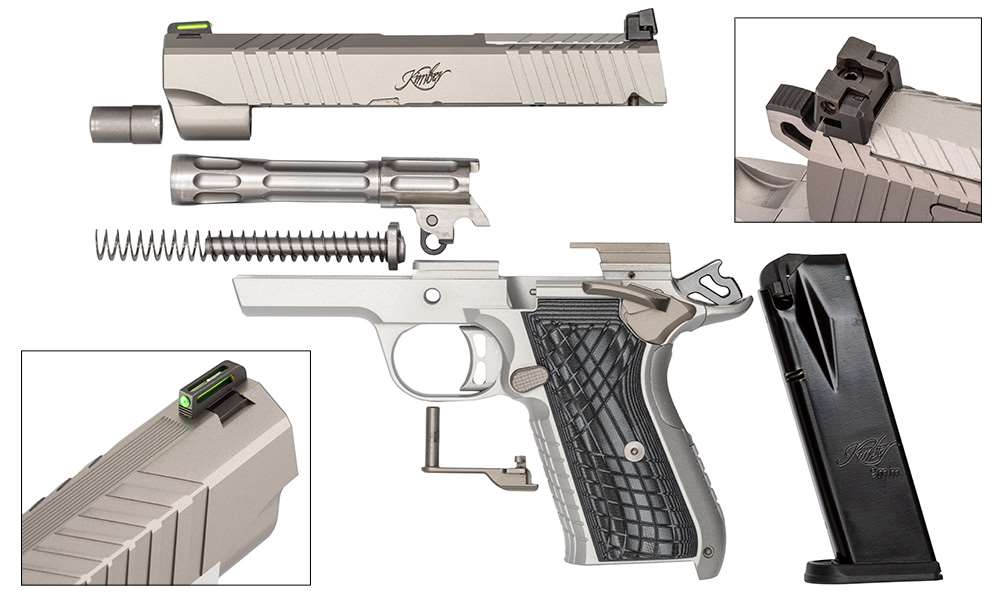
Kimber’s little double-stack is immediately M1911-like in appearance, but it boasts a list of features that distinguish it from the original Browning design. Starting at the muzzle, the KDS9c has a visually striking, deep-cut crown that extends the 20-degree cut all the way out to the edge of its fluted, cone-shaped barrel. The barrel lacks the twin locking lugs found on traditional M1911-style pistols and instead locks on the forward edge of the ejection port as most other contemporary pistols do. The flat-wire recoil spring assembly, guide rod and plug are a melding of the M1911 style and the approach popularized by the Glock line of pistols. The barrel is locked into the frame via the slide stop pin traversing through a traditional M1911 barrel link.
The Kimber has a beefy external extractor in place of the tensioned, internal hook found on the M1911. Makers have tried for years, often unsuccessfully, to adapt external extractors as found on nearly every other pistol design to the M1911; Kimber was able to design the external extractor into the KDS9c from the beginning.
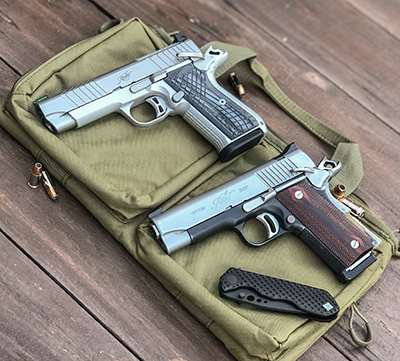
This pistol’s frame has a prominent and well-shaped beavertail, as one would expect to see to protect the hand from the hammer; however, the pistol does away with the grip safety. The part has seams and joints much as its cousins with grip safeties do, simply to allow access to the trigger and internal lockwork for assembly. Grip safeties are a point of contention for many, but I am happy to see Kimber allow the new compact to function as a cocked-and-locked single-action with a thumb safety and no grip safety—just as the Browning Hi Power, CZ 75 and variants of the H&K USP, Beretta 92 and SIG P226 have for many years.
The Kimber’s magazine body is sized specifically to the 9 mm Luger cartridge, in contrast to many popular 2011-style pistols, which employ a rather huge magazine designed to house a double column of large .45 ACP cartridges that is then adapted down to 9 mm. Using a 9 mm Luger-specific body gave Kimber the surest chance for reliability as well as latitude in shaping a small, comfortable grip frame.
Most of the popular pistols on the market use magazines that are each traceable to one of just a few highly proven designs, with minor changes in follower, magazine catch location, tube length and baseplate distinguishing them. The KDS9c magazine body and taper looked quite familiar to me, so I grabbed a surplus Beretta M9 (92FS) magazine and filed a new notch to match the magazine catch location—sure enough, the Kimber ran smoothly with the adapted M9 magazine.
The KDS9c has a catching visual profile. It is at once reminiscent of a traditional M1911 and modern on the verge of futuristic. Everyone, both shooters and non-gun-folk alike, who saw the Kimber in the months I was working with it commented unprompted how attractive they thought it looked. It is one of those pistols that looks even better in person than a still image conveys. The pistol’s triangular-profiled slide contributes to its appearance, as do the serrations that carry onto the slide’s top in a 90-degree angle to create a chevron effect. I found the serrations to be nicely functional as well as aesthetically pleasing. The swept nose of the slide creates a unique angle that is also carried onto the forward edge of the dustcover and repeated at the front of the trigger guard.
The frontstrap has a unique, non-snagging geometric serration that plays across the G10 stock panels and onto the mainspring housing. Sometimes sharp checkering on carry pistols can snag or abrade some shirt materials or suit linings, but the serrations here are shallow and unlikely to offend. I found them to offer little traction in use, and the attractive silver KimPro finish has a slightly slick feel to it, which added to the pistol wanting to shift under recoil. I added stair-tread tape to key spots on the front- and backstraps on my second range session to anchor the pistol and would be inclined to leave them there if it were mine.
The controls on the pistol mimic a well-set-up M1911, although they appear to be KDS9c-specific parts. I really liked the shape and effectiveness of the slide stop, magazine catch and, particularly, the thumb safety. The safety snicked on and off with the ideal amount of resistance, and its shape was at once effective, low-profile and comfortable. It is single-sided for right-hand use, and market reception may determine if bilateral units are available downstream.

The frame is almost identical in height to an Officer’s M1911, a Glock 19 or similar. The double-stack magazine, recurve at the bottom of the frontstrap and “roundbutt”-style treatment to the backstrap give the pistol a unique feel. The controls and trigger suggest M1911, but the frame feels more to me like the old Beretta 80-series compacts, which have always been regarded as great-feeling little pistols.
Overall, the finish was nicely executed with one machining imperfection where the trigger guard undercut met the frontstrap. Even though there are attractive flat/square areas meeting curves and rounds, there were no sharp edges, corners or “hot spots” anywhere on the pistol.
The slide-to-frame fit was excellent, about as close as one can get in a production pistol without hand-lapping the rails. The bushingless cone barrel had very slight play at the front and considerable play both vertically and horizontally at the ejection port. I had to remind myself that the new Kimber locks differently than a conventional M1911, so the traditional thumb check on the barrel hood may not compare as apples-to-apples. On several newer designs, the manufacturers have seemed to err on the side of looser tolerances to favor maximal reliability at launch, and it appears Kimber may have done so here.
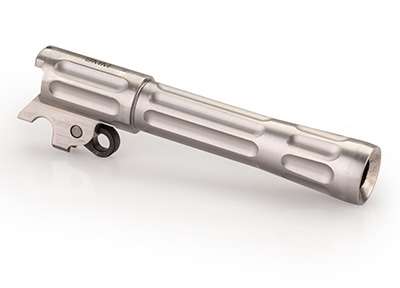
The Kimber is optics-ready, with a cover plate secured by two screws from the slide’s bottom much as with the SIG M17/M18. A Shield footprint adapter is available as an accessory item from Kimber to mount a red-dot optic. I was looking forward to mounting the popular Holosun EPS, as well as the Bushnell RXC 200, to the pistol to evaluate how the KDS9c performed with those optics, but Kimber was unable to provide a plate during the review process.
For many shooters, the whole point of a pistol like the KDS9c is to get the storied M1911 trigger break matched up to a double-stack. Kimber specs the trigger pull weight at between 3 lbs., 8 ozs., and 4 lbs., 8 ozs., and the test pistol started right at 4 lbs. and wore-in to a superb, 3-lb., 11-oz., break. There is a small amount of unweighted pretravel, a tactile wall and a smooth break—which feels like a crisp ledge but is actually breaking over a short movement with no overtravel. The trigger is significantly better than many of the 2011-style widebody pistols I’ve handled and will draw approving nods from experienced single-action shooters. If this were to be a dedicated carry pistol for me, I would like to see the weight closer to the 4-lb., 8-oz., side of the spec range.
The compact fit nicely into a wide variety of 5" M1911 holsters I tried. Some Commander-specific holsters would not fit (or might require remolding/modification) due to the unique dustcover shape. The Kimber also worked well in some concealment holsters intended for slimline Glock 48s or Springfield Hellcat RDPs. Oftentimes, a new pistol design can be frustrating due to limited holster selection, but many shooters probably already have several favorites in their holster box that will work with the KDS9c.
I fired a little more than 650 rounds through the Kimber over the space of a couple of months. There was one fluke stoppage when firing the pistol for groups from the rest. The slide caught one round mid-cartridge rather than stripping it from the magazine, but it seemed to be an anomaly from the otherwise smooth cycling throughout. I lubed the pistol early with Gunfighter Gun Oil and did not clean it or add any lubrication throughout the rest of firing. Where I habitually like to re-lube an M1911 in about 250- to 300-round intervals and give a casual wipe down to remove carbon accumulation every 500 rounds or as needed, the KDS9c seems to be purring along fine well past that. My sense is that it will shrug off indifferent cleaning and lubrication much more easily than some of its pure M1911 cousins. Extraction/ejection was brisk and positive; the external extractor and extended ejector seemed to launch empties consistently and farther from my firing point than my 9 mm M1911s do.
Many shooters appreciate hammer-fired pistols, whether single-action or DA/SA, for their perceived “softness” in recoil relative to striker-fired pistols of similar weight. Recoil on the Kimber was not at all unpleasant but was also somewhat sharper than I expected, with the slide seeming to cycle at a velocity and manner much more like a compact, striker-fired semi-automatic than the dampened-type effect of the mild-mannered 9 mm M1911. 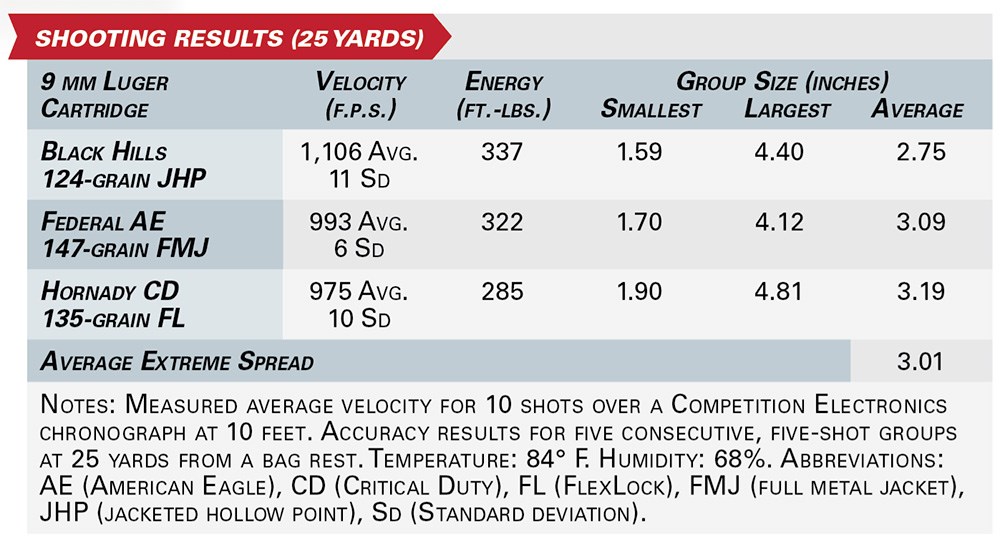
Wanting to have a better sense of what I thought I was feeling, I grabbed the KDS9c, a Wilson EDC X9 and a Dan Wesson TCP. I backed off to about 22 yards from a 12"x21" steel target and launched several magazines each of 124-grain Blazer in pairs just to get a sense of comparative muzzle rise and feel of the recoil. There was a noticeable difference between the Kimber and the Wilson and another difference between those two and the similarly sized/weighted TCP, which is a noticeably mild-shooting pistol. The Kimber carries most similarly to my Glock 48 slimline, so I shot the two of them side by side, and the KDS9c shot a notch or two softer.
I found the Kimber to be an able partner in a wide variety of challenging practical drills and tests. The KDS9c cleaned the popular and challenging low-round-count vintage Bakersfield Police qualification. Running some of Federal’s coated Syntech flat-point training rounds, the KDS9c maxed out the Double & 1 drill with pairs on a bullseye target from 2.5 out to 20 yards and then put in a Master level score on the IDPA 5x5 classification course.
Since I was training up for an NRA Action Pistol competition, I shot the Kimber against the falling plates out to 20 yards, drawing from concealment to attempt to hit each of six 8" plates in seven seconds (15 yards) or eight seconds at 20 yards. That sounds easy until the shot timer beeps, but the excellent trigger and fiber-optic front sight on the Kimber let me ring six for six with some time to spare more than once, and the occasional plate I left standing was no fault of the pistol. This is an excellent test for a demanding level of accuracy from a capable carry pistol.
I was curious what the Kimber would handle like if the aftermarket were to offer slimline stock panels to boost concealment or fit smaller hands even better, so I removed the issue panels and shot it bare. The stock panels give the pistol a pleasant ovular cross section that is quite comfortable, but I hope that Kimber or a maker like LOK Grips provides an option for super thin, flat panels as well. I carried and shot the KDS9c with the panels removed and found the more square feel gave me excellent purchase while making the already-slim pistol even smaller.
There is a lot to like in the new Kimber. Holding it side by side with my old custom-shop .45 ACP Elite Carry Officer, it is a pistol of nearly the same compact size and weight in a reliable 15-shot format ready to accept an optic. I am excited to see aspects of the venerable M1911 carried forward with thoughtful updates and changes. For fans of single-action semi-automatic pistols, these are truly great times.